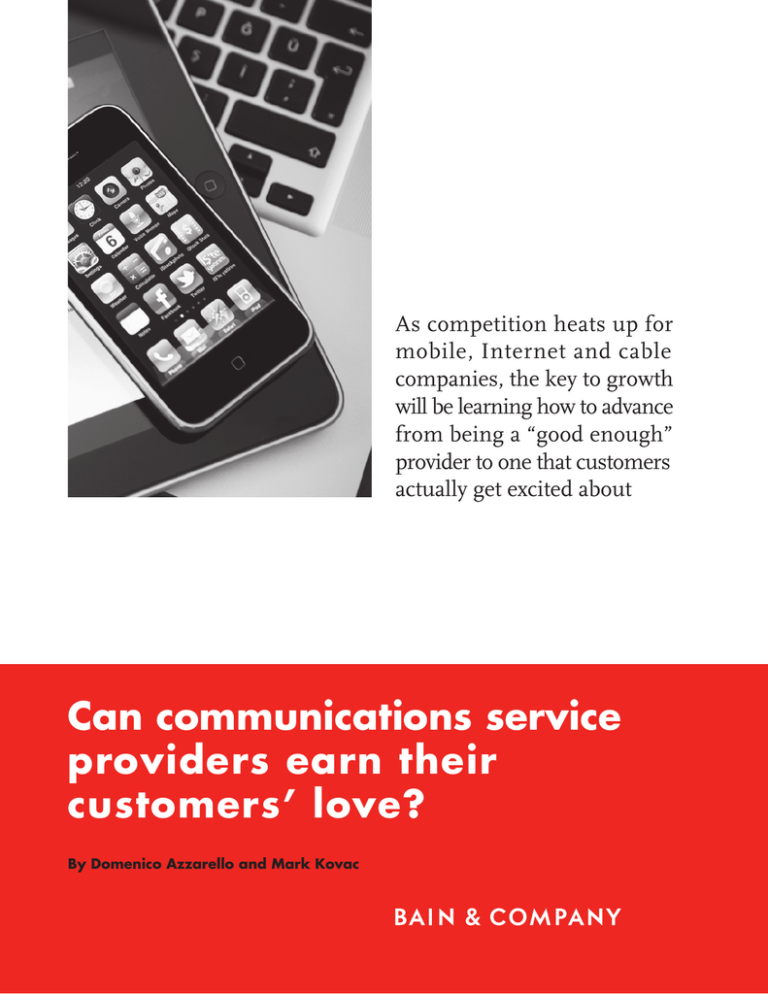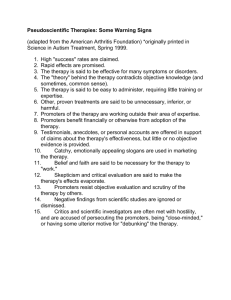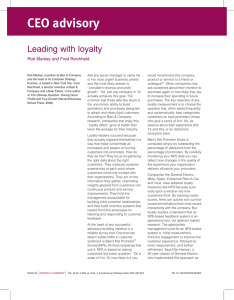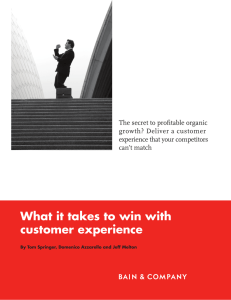
As competition heats up for
mobile, Internet and cable
companies, the key to growth
will be learning how to advance
from being a “good enough”
provider to one that customers
actually get excited about
Can communications service
providers earn their
customers’ love?
By Domenico Azzarello and Mark Kovac
Domenico Azzarello is a Bain & Company partner in Paris.
Mark Kovac is a partner in Dallas.
Copyright © 2011 Bain & Company, Inc. All rights reserved.
Content: Global Editorial
Layout: Global Design
Can communications service providers earn their customers’ love?
As competition heats up
for mobile, Internet and
cable companies, the
key to growth will be
learning how to advance
from being a “good
enough” provider to one
that customers actually
get excited about.
Ask a friend whether he would recommend his
mobile phone, Internet or cable provider, and
chances are you won’t be convinced to sign on
with that company. The truth is, across all three
markets, customers typically go with the provider
they feel is “least objectionable” rather than one
they feel strongly about using—or even better,
one that they would recommend to friends. This
apathy doesn’t need to exist. Wireless customers,
for example, are often quite enthusiastic about
the devices they use (consider the passions of
iPhone vs. Android users). But few service providers win true affection or loyalty.
As long as subscriber numbers continued to grow,
providers accepted being “good enough” in customers’ eyes. In cable and Internet services, the absence
of significant competition helped. But companies
in all three markets now compete on a changed
playing field. With penetration flattening (wireless
penetration in the US, for example, is nearly 100
percent) and competition intensifying, companies
must fight for market share as never before.
As a result, the strategic priority for communications service providers has shifted dramatically
from simply acquiring customers to keeping the
customers they already have. What does this
mean? Having an acceptable performance is no
longer good enough. To be successful, providers
will need to earn their customers’ love—in large
enough measure for customers to choose to stay
loyal when tempted by competitive offers.
Providers understand the theory of retaining
customers and reducing churn. The first step is to
eliminate the factors that would make a customer
walk away—factors like poor network coverage
or an inefficient and frustrating customer call
center where customers are transferred four or
five times before reaching the right agent. Many
are making the organizational and process changes
required to solve these and other problems that
cause customer dissatisfaction.
That’s a necessary step, but it’s not sufficient to
win customers’ hearts and minds and truly differentiate against competitors. The fact is that
the ultimate industry leaders will be those companies that deliver consistently on the basics and
then go the extra step to delight customers, as
opposed to just avoiding offending them. These
winning providers will spark a “wow” effect with
the people who buy and use their services—as
Apple does with customers of its computers and
handsets. Put another way, the long-term winners
will be those that create true customer promoters
of their products and services.
One effective way to measure the level of customer enthusiasm, and learn how to improve
it, is with the use of the Net Promoter® system.
To start out, companies should measure their
Net Promoter score (NPS®) by asking customers
a single question: “How likely are you to recommend [this company or product] to a friend
or colleague?” Respondents giving marks of
nine or 10 are promoters, the company’s most
devoted customers. Those scoring their experience at seven or eight are passives, and those
scoring it from zero to six are detractors. NPS
is the percentage of promoters minus the percentage of detractors (see sidebar: NPS 101—
Building a Net Promoter system with closedloop feedback).
Clearly, a company’s promoters and its NPS
relative to competitors’ are critical to its success.
To understand the value each promoter brings
to a communications service provider, Bain &
Company recently surveyed almost 3,000 US
1
Can communications service providers earn their customers’ love?
customers in the three communications service
markets: wireless, fixed Internet and pay-TV.
We found an empirical link between profitable
growth and a company’s NPS relative to its
competitors’ (see Figure 1). There is a link to
several value creators, including reduced churn,
increases in revenue per user and referrals. In
other words, customers stay longer, buy more
and tell their friends. They also give useful feedback that can help improve the business.
Each of these elements can be quantified. We
found that, across the board, promoters are consistently far more valuable than detractors. In
the wireless market, for example, promoters
generate on average nearly 80 percent higher
lifetime revenue than passives and nearly two
and a half times more revenue than detractors,
based on their longer tenures. They are far less
likely to churn than passives and detractors
(see Figure 2).
Just as important, promoters—as the name
implies—are more willing than other customers
to recommend the provider to potential customers. In wireless, for example, promoters recommend to six people on average. In Internet
and cable, they generate on average 4.6 referrals,
according to our study. They also serve to lower
the cost of acquiring subscribers. Because promoters are essentially doing some of the marketing, companies don’t have to spend as much
as their competitors. Clearly, in an environment
marked by increased competition and slower
growth, promoters have the ability to dramatically swing momentum toward—or away from—
individual providers.
To turn customers into advocates,
providers need to know what
customers love
Despite the importance of promoters, NPS
scores are, on average, low for communica-
Figure 1: An empirical link exists between customer loyalty and profitable growth in wireless telephone services
EBITDA growth (Q3 2009–Q3 2010)
R2= 0.48
30%
20
10
0
10
Number of
subscribers
20
60
40
20
0
20
Relative Net Promoter score (rNPS)
Sources: Bain eRewards Wireless NPS Benchmark–September 2010; Wireless Intelligence; company quarterly and annual reports
2
40%
Can communications service providers earn their customers’ love?
Figure 2: NPS correlates well with customer value
Promoters churn less frequently…
Expected monthly churn
3.8%
4%
3.2%
3
1.9%
2
1.9%
1.2%
1
0
2.9%
1.7%
0.9%
0.9%
Mobile
Pay TV
Internet
…leading to higher lifetime value
Expected lifetime revenues
$9.9K
$10K
8
6
$4.8K
4
$4.5K
$4.3K
$2.7K
$2.3K
2
0
$9.0K
$7.9K
Pay TV
Mobile
Promoters
Passives
tions service providers vis-à-vis many other
industries, with many companies facing more
detractors than promoters. So the challenge
for mobile, Internet and cable providers is to
understand the key factors that turn customers
into promoters.
Bain’s recent survey gave us important insights
into what companies can do to gain ground with
customers. First, customers want companies to
satisfy their needs in the basic areas such as
price, network coverage and customer service.
These are the table stakes. But to gain a competitive advantage, operators must then exceed
expectations on some elements of the customer
experience. Providers need to figure out which
areas matter for their customers and determine
where there is significant value in over-delivering.
In short, providers need to prioritize investments
based on the risk of angering customers and the
potential of wowing them—and to focus on those
dimensions that are perceived as most valuable
$2.7K
Internet
Detractors
for the customer. These sources of differentiation
are likely to vary by customer segment.
In wireless, for example, we found that many
customers like to be notified if they go over their
plan limits. In fact, they find such notification
as attractive as a $4 monthly discount on their
bill (see Figure 3). We also determined the value
of other possible benefits. Giving customers a
single point of contact would be worth the equivalent of $3.70, and offering a 25-cent refund for
every dropped call could be as valuable as a $3.60
discount. In other areas, our survey found that
it isn’t even worth investing unless you can
exceed expectations. These include offering
bundled deals or the flexibility to change plans.
By analyzing customer data for all product and
service elements, we identified the 10 critical dimensions of the customer experience in which
companies have the biggest opportunity to win,
delight and keep their customers.
3
Can communications service providers earn their customers’ love?
Figure 3: New practices could provide additional value to mobile customers
Average monthly equivalent value of additional mobile services
Monthly equivalent value (industry average)
$6
$4.3
$4.3
4
$3.7
$3.6
$3.0
$2.5
$2.1
$2.1
$2.0
Provide
unlimited
voice/texts
on important
days
Give me a
deal for
referring
my friends
Preload
apps
2
0
Notify me
before I go
over my
plan’s limits
Give me
points
Provide a
single point
of contact
Refund 25
cents for
every
dropped
call
Back up
my phone’s
data online
Notify
me if my
service
will be
down
Source: Bain US Telco Customer Experience Survey, February 2011, n=~1,000 for each service
Win me!
•
Be a champ about resolving issues.
•
Find out what excites different customer
segments, and create a value proposition
to satisfy them.
•
Create pleasant and effective processes for
upgrading, cross-selling, renewing and
relocation services.
•
Get the customer to talk about your positive
attributes to the right people, especially on
social media.
Keep me!
•
Be passionate about educating customers
when you sell to them, and make installation and activation as smooth as possible.
•
Let your high-value customers know they
are your high-value customers—and shower
them with rewards.
•
Know how to proactively detect when your
customers are disappointed—and know
how to change their minds.
When customers opt to cancel, have a plan
for bringing them back (at least the ones
you want to keep).
Delight me!
4
•
Deliver an exciting product experience that
makes you different from competitors in at
least one area important to your customers.
•
•
Nobody likes receiving bills, but at least
keep customers from complaining by providing bills that are clear and accurate.
Learning from the best
Communications service providers can innovate
and differentiate on these dimensions to gen-
Can communications service providers earn their customers’ love?
erate “wow” effects and earn the passionate
loyalty of their customers. In doing so, they can
draw ideas from customer experience leaders
in their own markets and in others.
Win me!
Find out what excites different customer segments, and create a value proposition to satisfy
them. The truth is that communications service
providers have much room for improvement
when it comes to customizing product or service
packages for particular customer segments.
However, some providers are finding success
in this area. For example, MetroPCS Communications tailors its service to price-sensitive
customers—those who want to make sure they’ve
got the least-expensive deal. There are no bill
surprises. It’s all prepaid, with no need to count
minutes. And it’s simple to understand. In an
industry known for complicated bills and hidden
charges, this creates the highest NPS scores in
the industry. Or consider DirectTV, which has
been pursuing a different segmentation approach.
Until now, most cable companies’ TV offerings
have been fairly standard, comprising a basic
package with only a few premium options (which
often require customers to buy channels that
they don’t want in order to get the ones they do
want). DirectTV was willing to wager that a
segment of customers would pay premium
rates for the best sports package—a large number of sports channels and interactive services.
The approach has paid off for DirectTV, which
has earned an NPS of 23 percent, far above the
industry average of 6 percent.
Get the customer to talk about your positive attributes to the right people, especially on social
media. Customers are highly influenced by
friends. That’s why winning companies work
hard to enable customer promoters to convince
friends about the benefits of their service, particularly friends who are likely to become promoters
themselves. Today, there’s no substitute for social
media as the channel for creating buzz and referrals. Dell is one company working to make the
most of social media. The company’s @DellCares
service allows it to interact with potential customers
online and facilitate promoter interactions with
potential customers. Its Social Media Listening
Command Center proactively monitors the Internet for potential customer complaints. Under
the program, forums facilitate customer-tocustomer support, customer service issues are
addressed on Twitter and YouTube videos provide self help. Meanwhile, Dell Outlet offers
engaged customers flash promotions through
Twitter. Corporate blog Direct2Dell facilitates
customer-to-company leader discussions. Finally,
IdeaStorm.com allows customers to propose
product and service improvements.
Be passionate about educating customers when you
sell to them, and make installation and activation
as smooth as possible. Many service providers
tend to overlook the sales process as the first
opportunity to build long-term loyalty. In contrast
to some of its peers, UK-based mobile operator
O2 developed a winning approach. Throughout its
retail stores, the company employs approximately
400 technology gurus who assist customers
as they buy a new smartphone, demonstrate how
to use the product and set up the new customer’s
personal account. The customer walks out of the
store already proficient on the product. A digital
guru, easily accessible via a smartphone icon,
also becomes a way for the customer to obtain
remote assistance after purchasing the phone.
Delight me!
Deliver an exciting product experience that makes
you different from competitors in at least one
area important to your customers. There are
two ways to create a “wow” product experience.
One is to introduce new features, as Netflix did
with its adaptable video-on-demand interface,
which allows users to customize the video format to their viewing preference. The other is to
differentiate on one specific dimension of the
product experience, like user-friendliness, speed,
coverage or handsets, as AT&T was able to do
with its iPhone exclusivity.
5
Can communications service providers earn their customers’ love?
Nobody likes receiving bills, but at least keep
customers from complaining by providing bills
that are clear and accurate. Customers often cite
billing as one of the most frustrating aspects of
their relationship with their service provider.
They complain about confusing bills, mistakes
(actual or perceived) or simply the inability of
the provider to resolve issues. While it’s not easy
to use billing to delight customers, some companies have taken steps to reduce dissatisfaction
due to bill frustration. American Express, a loyalty leader in financial services, differentiates
its billing program by using online tools that
make it easy for customers to review their bills
and understand what they’re buying. By making
the billing process less painful, companies can
not only avoid frustrating customers to the
point of detraction, they can actually increase
satisfaction through a positive interaction.
Be a champ about resolving issues. Bain’s work
has suggested that solving customer service
issues is a critical pain point for customers of
communications service providers. In this area,
providers could benefit by looking at what works
so well for Amazon.com. The online retailer’s
“call me now” and “call me in five minutes”
options—available on the site’s customer service
page—are designed to tackle problems quickly,
eliminating the need for a customer to wait to
talk to a customer service representative and ensuring that representatives are aware of customers’ problems as soon as they get on the phone.
Create pleasant and effective processes for upgrading, cross-selling, renewal and relocation
services. A key part of retention is the ability to
cross-sell or ensure renewals at critical contract
points. To increase satisfaction, SK Telecom wants
all customers to have access to the latest handsets,
so it offers two ways for customers to get them
whenever they want: Rolling subsidies make it
easier for customers to afford new handsets
before the end of their contract, or customers
can spread the cost of a new phone evenly over
the bills that remain for that contract. In a differ6
ent example, another wireless company watched
its NPS for relocation customers jump from
-40 percent to +10 percent by simply creating
a single point of contact for customers in the
process of relocating.
Keep me!
Let your high-value customers know they are
your high-value customers—and shower them
with rewards. All too often, long-term customers
become frustrated by deals that apply only to new
customers, while they see little reward for their
long-term loyalty. In this area, providers could
take a lesson from credit card leaders, whose
high-value card members are routed to the best
representatives upon dialing a call center. Within
the industry, wireless provider US Cellular uses
tenure as a basis for providing loyalty points redeemable for desirable products and services.
The loyalty program is one part of its broad effort
to address several customer pain points and treat
its high-value customers better than the competition might—a strategy that has helped the
company achieve an NPS that’s two times the
industry average.
Know how to proactively detect when your customers are disappointed—and know how to
change their minds. Leading companies monitor
potential triggers of customers at risk of churn—
events like bill spikes, complaint calls or payment
problems. At one wireless provider, no fewer than
15 percent of its customers experience a potential
churn trigger every month. Those at-risk customers are proactively called, and customer service
representatives offer customized solutions such
as no-fee plan switching or extra loyalty points.
In its first six months, the process reduced churn
and led to a 15 percent fall in deactivation calls.
When customers opt to cancel, have a plan for
bringing them back—at least the ones you want
to keep. Companies need to have a system for
identifying the root causes of customer churn,
assessing the economic benefit of saving the
Can communications service providers earn their customers’ love?
customer and determining which specific offers
or services will entice the customer to stay—it
may be a less expensive plan or a more flexible
plan. One provider monitors its competitors to
detect new, enticing offers before—or at the moment when—they hit the market. The company
then quickly lays plans to react with equally
attractive counteroffers. The provider also has
a system in place for customer service agents—
often the first to hear about competitive plans—
to alert the company to such programs. Of course,
there are a few cautions with this approach. First,
retention-offer marketing development must be
nimble enough to quickly customize and test
response offers. Second, the increased generosity
of counteroffers creates a buzz that results in
numerous clients calling to get in on the deal. To
reduce such spillover effects, companies need to
provide generous retention offers only to those
customers who are at risk of churn, and they need
to train customer service agents to identify such
individuals. Areas to manage and measure carefully: competitor moves, how much to invest in
keeping a customer and the potential for creating a spillover effect.
The ultimate differentiator is the ability of an
operator to deliver a full, end-to-end experience
that is consistent with its vision and customer
promise. For example, TD Bank lives its vision
of being “America’s most convenient bank.” The
bank is open seven days a week—even holidays—
and provides such services as mobile banking
and free coin counting. It delights customers
with everything from free dog treats to candy for
children to umbrella escorts. Employees are
delighted, too, with surprise parties and rewards
for NPS-leading branches and agents. Based on
its efforts, TD Bank claims the highest NPS
among its peers in the Northeast US, earning a
19 percent score vs. the industry average of 5 percent for regional banks. Such customer loyalty
has led TD Bank to become the leader in domestic deposit growth—and a clear example of how
to get customers to love a company.
Getting started
Our work with clients across the communications
services industry has enabled us to develop an
effective approach to improving the customer
experience and boosting customer loyalty.
Create the vision and roadmap. Companies need
to determine their point of departure—their
current status—and the point of arrival they hope
to reach. This begins by asking some fundamental questions about their current experience with
customers and what, specifically, they hope to
achieve (see sidebar: Knowing your point of
departure and point of arrival).
Define the case for change. The challenge here:
conduct a dive deep into the customer experience
to discover the elements that matter the most.
Then use a pragmatic and systematic methodology (and a data-driven approach) to prioritize
where and how much to invest—and how much
it would be worth. This is not easy. It requires
using detailed data from customers to understand their true experiences, priorities and willingness to make tradeoffs based on the value
they assign to different products or services. But
it can pay off dramatically if done correctly.
Master the basics. Before investing to exceed
expectations, make sure you can meet them.
Understand the root cause of defection—events
or a series of events—and the priority of those
reasons for defection. Then redesign the customer experience and define the required
operational imperatives.
Create the “wow” effect. Think through where to
differentiate across the 10 dimensions listed
above. This may mean better segmenting your
customer base and tailoring your offering accordingly; it could mean more recognition of high-value
customers. Regardless, the goal is to understand
what will make a difference to your customers and
to have a laser focus on excelling in those areas.
7
Can communications service providers earn their customers’ love?
Build supporting processes and platforms. Transforming the customer experience is not a simple
process. It will require new platforms, new processes and significant retraining upfront, as well
as a longer-term customer feedback mechanism
to understand how you are doing, learn evolving
customer pain points and continuously improve
over time (often best achieved with a robust Net
Promoter system). By applying a structured
approach to the customer experience, companies
like Charles Schwab have improved performance.
Charles Schwab administers an NPS survey to a
large client base and makes branch managers
accountable for their customers’ scores. After
identifying dissatisfied clients, managers respond
personally to rectify the root cause of the problem.
The closed-loop feedback ensures that detractors
become satisfied customers. NPS scores have
increased 75 points since Charles Schwab started
its customer advocacy program and 40 points
since it began the closed-loop feedback process.
Transform the organization and culture. No effort
will be successful without ensuring that organizational interfaces and decision roles are consistent
with the new processes and without making
certain that the people behind the effort are both
well trained and enthusiastic. While it is one of
the toughest pieces to implement, ensuring that
the organization is structured and able to behave
differently is a critical step to success.
Only by understanding your customers and
what they want, and creating offerings that not
only meet but also exceed their expectations
where it matters most, can communications
service providers turn the big corner. It’s difficult. But providers that can get their customers
to love them and become vocal promoters—as
opposed to watching their customers wait for
the first excuse to abandon them—will outpace
their competitors over time.
Net Promoter® and NPS® are registered trademarks of Bain & Company, Inc., Fred Reichheld and Satmetrix Systems, Inc.
Knowing your point of departure and point of arrival
Building a vision and roadmap for change begins by answering a series of questions designed
to help your company understand where it now stands (its point of departure) and where it
hopes to be (its point of arrival).
•
What is the current experience for our customers? How are we performing against our
peers across critical dimensions of winning, delighting and keeping customers. Based on
the answers, the next questions to answer are: where do we need to be in five years in
order to be leading the industry in customer experience?
•
What is our NPS? Why are our promoters promoters? Why are our detractors detractors? Then,
what specific factors do we need to change to increase our promoters and convert detractors?
•
Do we have the right internal capabilities, organizational structure and culture to deliver exceptional customer experience? Then, what would our new organization look like in five years?
•
Do we have the right systems, metrics and benchmarks? Then, how will we adjust our ways
of working and align the organization accordingly?
8
NPS 101—Building a Net Promoter system with closed-loop feedback
NPS allows employees to immediately see whether a customer touch-point was a success or a
failure—and why. After customers give their numerical answer to the “How likely would you
be to recommend?” question, they are then asked to describe why they would be likely or unlikely to recommend the company based on that interaction. Their answers help employees
quickly identify issues that create detractors and the actions required to address them.
As they analyze customer feedback, companies should pay particular attention to the “moments
of truth”—interactions that hold the greatest potential to delight or alienate customers.
Frontline employees are best positioned to pinpoint such pivotal customer experiences and come
up with effective ways of improving them. A small customer-focus team, reporting directly to the
board, can design, build and test a feedback system for make-or-break experiences and then
roll it out to customer-facing employees.
Here’s how such a system could work: After every transaction, an independent polling firm immediately contacts the customer and conducts a brief survey. It emails the results to the employee
who provided the service and publishes aggregated results on the local intranet. Frontline
employees then follow up by calling a sample of customers who have agreed to be contacted.
After listening to the customers’ problems, they correct them or escalate them to someone who can.
Frontline employees have responsibility for improving their work unit’s feedback scores and meet
frequently to devise service improvements, both large and small.
Bain’s business is helping make companies more valuable.
Founded in 1973 on the principle that consultants must measure their success in terms
of their clients’ financial results, Bain works with top management teams to beat competitors
and generate substantial, lasting financial impact. Our clients have historically outperformed
the stock market by 4:1.
Who we work with
Our clients are typically bold, ambitious business leaders. They have the talent, the will
and the open-mindedness required to succeed. They are not satisfied with the status quo.
What we do
We help companies find where to make their money, make more of it faster and sustain
its growth longer. We help management make the big decisions: on strategy, operations,
technology, mergers and acquisitions and organization. Where appropriate, we work with
them to make it happen.
How we do it
We realize that helping an organization change requires more than just a recommendation.
So we try to put ourselves in our clients’ shoes and focus on practical actions.
For more information, please visit www.bain.com








